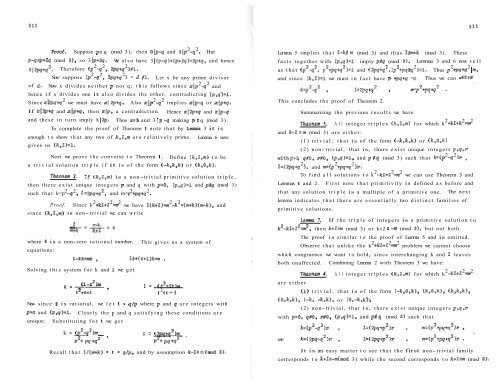Vol. 7 No 5 - Pi Mu Epsilon
Vol. 7 No 5 - Pi Mu Epsilon
Vol. 7 No 5 - Pi Mu Epsilon
You also want an ePaper? Increase the reach of your titles
YUMPU automatically turns print PDFs into web optimized ePapers that Google loves.
Proof.<br />
2 2<br />
Suppose p~ q (mod 3); then 3lp-q and 3lp -q . But<br />
p-qSpt2q (mod 31, so 3 \p+2q. We also have 3 l(p-q)+(p+2q)=2p+q, and hence<br />
2 2 2<br />
3 1 2 ~ ~ Therefore t ~ . (p -q , 2pq+q )#l.<br />
2 2 2<br />
<strong>No</strong>w suppose (p -q , 2pqtq ) = a' $1. Let x be any prime divisor<br />
of d. <strong>No</strong>w x divides neither p nor q; this follows since xip<br />
2<br />
-q<br />
2<br />
and<br />
hence if x divides one it also divides the other, contradicting (p,q)=l.<br />
2 2 2<br />
Since xbpq+q we must have x\ 2p+q. Also x\p -q implies x\p-q or xlptq.<br />
If xl2ptq and xlp+q, then xlp, a contradiction.<br />
Hence x12ptq and xlp-q<br />
and these in turn imply x 13p. Thus x=3 and 3 1 p -q making p E q (mod 3).<br />
To complete the proof of Theorem 1 note that by Lemma 3 it is<br />
enough to show that any two of k,l,m are relatively prime.<br />
gives us (k,l)=l.<br />
Lemma 6 now<br />
Next we prove the converse to Theorem 1. Define (k,Z,m) to be<br />
a trivial solution triple if it is of the form (-k,k,k) or (k,O,k).<br />
7hn.oit.e.m 2. If (k,l,m) is a non-trivial primitive solution triple,<br />
then there exist unique integers p and q with p>0, (p,q)=l and pfq (mod 3)<br />
such that k=p<br />
2<br />
-q<br />
2<br />
, ~ .=2~~tq, and m=p<br />
2<br />
tpq+q<br />
2<br />
.<br />
since (k.2.m)<br />
2 2 2 2 2<br />
Proof. Since k +kM =m we have Z(ktZ)=m -k =(m+k)(m-k), and<br />
is non-trivial we can write<br />
2 m-k<br />
= mt = = t<br />
where t is a non-zero rational number.<br />
equations:<br />
2-kt=& , Ztt(t+l)k=m .<br />
Solving this system for k and 2 we get<br />
This gives us a system of<br />
k=--, (1-t2)m<br />
2 = (t2+2t)m<br />
t2tttl<br />
t 2 tt+l<br />
<strong>No</strong>w since t is rational, we let t = q/p where p and q are integers with<br />
p>0 and (p,q)=l. Clearly the p and q satisfying these conditions are<br />
unique.<br />
Substituting for t we get<br />
Lemma 5 implies that 2-kf.m (mod 3) and thus Zfmtk (mod 3). These<br />
facts together with (p,q)=l imply p&7 (mod 3). Lemmas 3 and 6 now tell<br />
2 2 2<br />
us that (p2-q2, p2+pqtq2)=l and (2pq+q2, 2 p2tpqtq 2 )=I. Thus p +pqtq . lm,<br />
and since (k,Z)=l we must in fact have p +pq+q =m.<br />
This concludes the proof of Theorem 2.<br />
Summarizing the previous results we have<br />
Thus we can wr'it<br />
2 2 2<br />
The.ote.rn 3. All integer triples (k,Z,m) for which k tkZ+k =m<br />
and k-Zzm (mod 3) are either:<br />
(1) trivial, that is of the form (-k,k,k) or (k,O,k)<br />
(2) non-trivial, that is, there exist unique integers p,q,v<br />
2 2<br />
withp>0, q#O, v#O, (p,q)=l, and p fq (mod 3) such that k=(p -q )r ,<br />
2 2 2<br />
2=(2pq+q 1, and m=(p +pq+q )r.<br />
2 2 2<br />
To find all solutions to k -kZtl =m we can use Theorem 3 and<br />
Lemmas 1 and 2.<br />
First note that primitivity is defined as before and<br />
that any solution triple is a multiple of a primitive one.<br />
The next<br />
lemma indicates that there are essentially two distinct families of<br />
primitive solutions.<br />
Lennna 7.<br />
If the triple of integers is a primitive solution to<br />
k2-k2+12=m2, then k+Z%m (mod 3) or kt2 -m (mod 31, but not both.<br />
The proof is similar to the proof of Lemma 5 and is omitted.<br />
2 2 2<br />
Observe that unlike the k +k2+2 =m problem we cannot choose<br />
which congruence we want to hold, since interchanging k and 2 leaves<br />
both unaffected.<br />
are either<br />
(O,k,k),<br />
Combining Lemma 2 with Theorem 3 we have:<br />
2 2 2<br />
Theolem 4. All integer triples (k,l,m) for which k -kl+l =m<br />
(1) trivial, that is of the form (-k.0.k). (k,O.k), (k,k,k),<br />
(4, -k,k), or (0,-k,^;<br />
(2) non-trivial, that is, there exist unique integers p,q,Y<br />
with p>0, q#O, &O,<br />
(p,q)=l, and ptq (mod 3) such that<br />
k = (p2-q2)m 2 = ( 2pqtq2 )m<br />
p2+ Pa +q2 p2+ to2 '<br />
Recall that Z/(m+k) = t = q/p, and by assumption k-2s m (mod 3).<br />
It is an easy matter to see that the first non-trivial family<br />
corresponds to ktZs-m(mod 3) while the second corresponds to k+23 (mod 3).
















